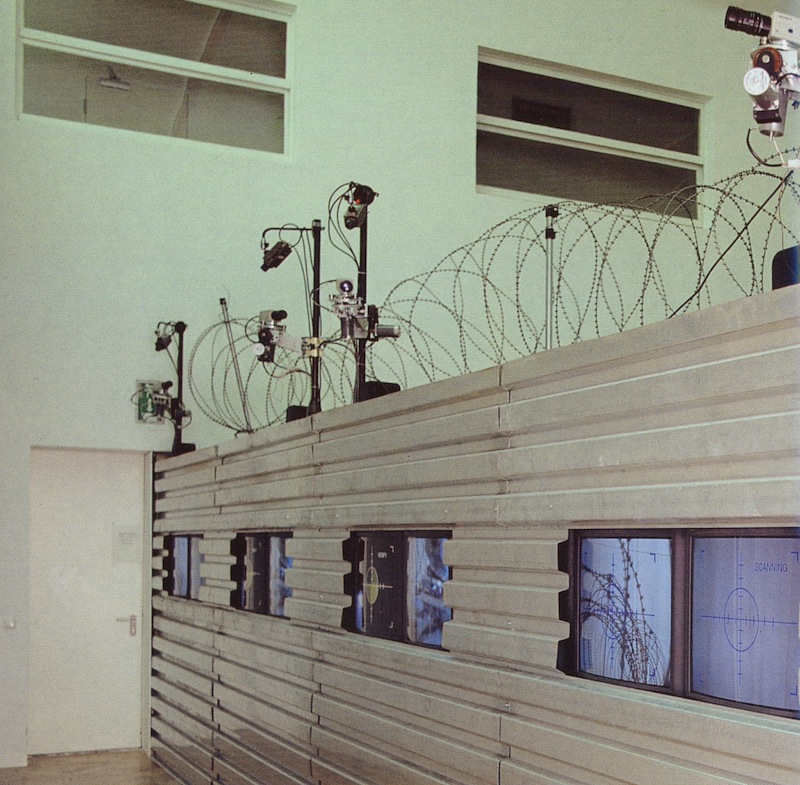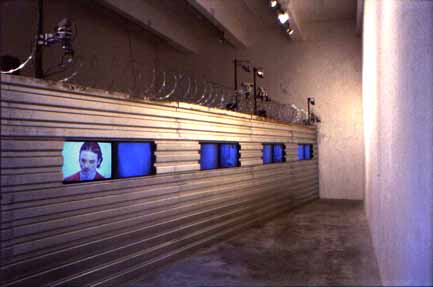Rokeby : Home
/ Works / Current
Shows / Texts / softVNS
/ Links / e-mail
me
Interactive Installations : Border Patrol (collaboration with Paul Garrin)
(1995)
Commissioned for the Kwangju Biennale
awarded a Prix Ars Electronica award of Distinction in Interactive Art (1997)

Border Patrol at the OK Center, Linz (1998)
Border Patrol was a collaboration between Paul Garrin and myself. The concept and style are very much Paul's. I started out on this (and Paul's previous projects "Yuppie Ghetto" and "White Devil") primarily as the technical guy. This is something I rarely do, but Paul's energy, intensity and conviction were infectious. By the time we had finished "White Devil", the degree to which the works were being substantially defined by the technologies we used was becoming obvious, so for "Border Patrol", Paul graciously suggested that the work be considered a collaboration. Paul was always respectful of my own stature as an artist while working with me, which is something that was rarely the case in the 80's and 90's, and tales of bad fallings-out between artists and programmers / technicians were legion.
The work was commissioned for the first Kwangju (now Gwangju) Biennale in Korea in 1995. Paul was interested in the dividing wall between the two Koreas. He had been in Berlin during the fall of the Berlin wall. He was also very interested in the wall dividing the USA from Mexico (and indeed, pretty much any wall designed to keep have-not's away from the property of have's).
The piece was made up of a wall, topped with razor-wire, with multiple embedded screens in its face. Four robotic cameras were mounted on the wall, each with a secondary tracking camera. My software located heads within the images of the tracking cameras and directed the robotic cameras to follow heads as precisely as possible. The robotic cameras were very fast, and had very long imposing lenses on them. Spookily, as the camera followed you , you were always looking directly down the "barrel" of the lens.
The images from the robotic cameras were displayed on the embedded screens, and once the system had locked onto a head, crosshairs would form and the sound of sub-machine gun fire would rip out of the hefty subwoofers behind the wall.
We refined the system in a studio space in the East Village in Manhattan. I remember that the first time we got the tracking to work, we were both astonished and shocked by the visceral sense of evil we both felt. We were surprised at later shows to see that people often giggled and checked their hair in the screens as the cross-hairs formed over their heads. We found the system scarier than any later viewer.

Installation shot from the Holly Solomon Gallery, NYC (1996)
History
1995
Kwangju Biennale, Kwangju, Sounth Korea
1996
Holly Solomon Gallery, New York City, U.S.A.
1998
O.K. Center for Contemporary Arts, Linz, Austria
Rokeby : Home / Works
/ Current Shows / Texts
/ softVNS / Links
/ e-mail me
Copyright 2010 David
Rokeby / very nervous systems / All rights reserved. 11/25/2010


